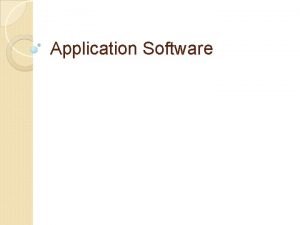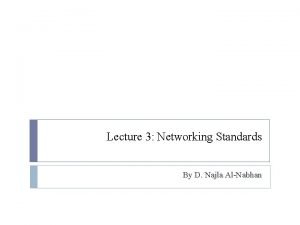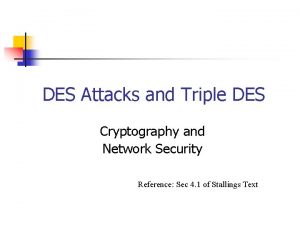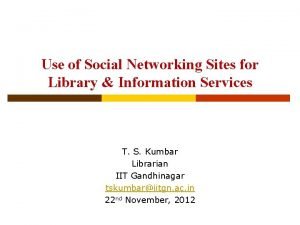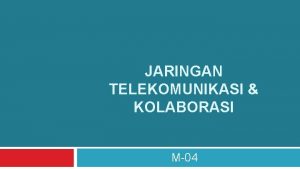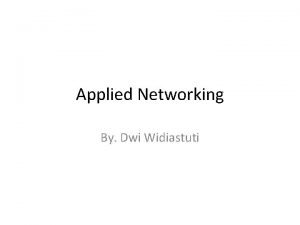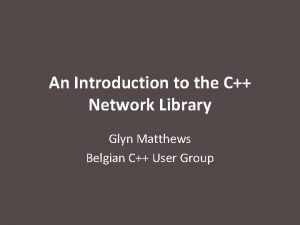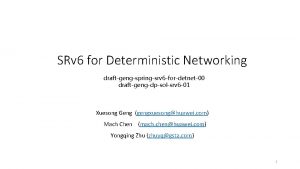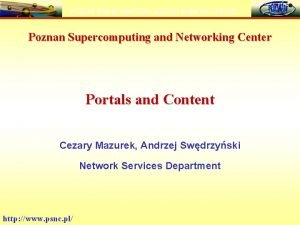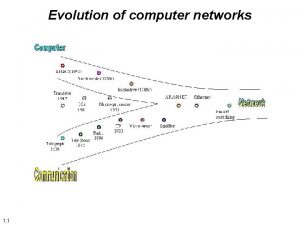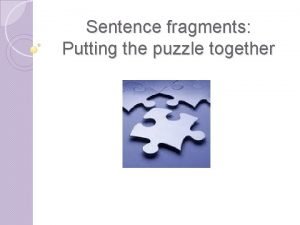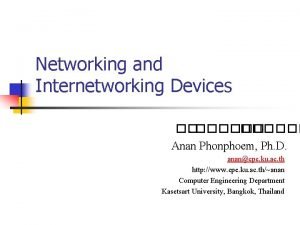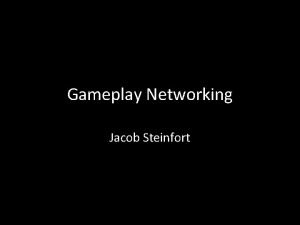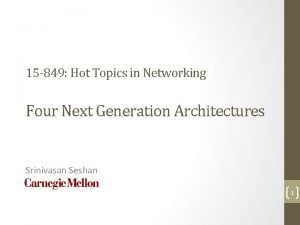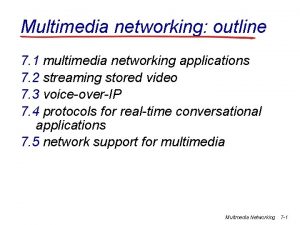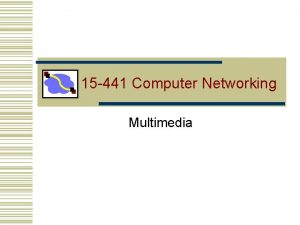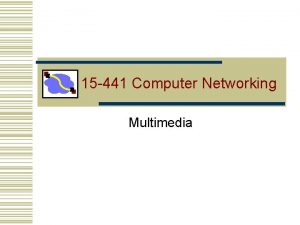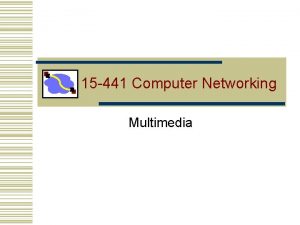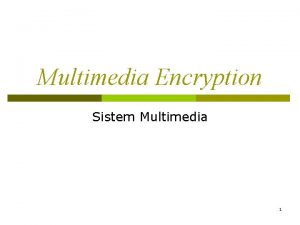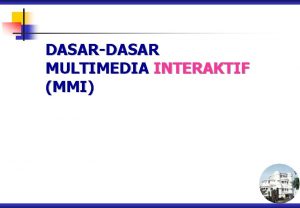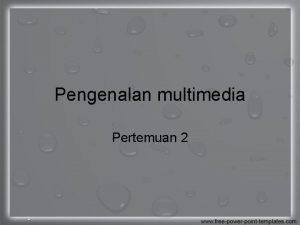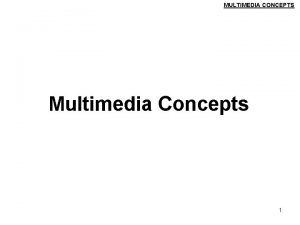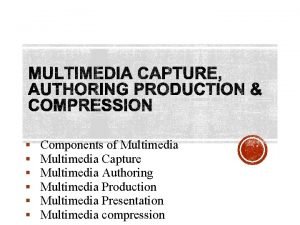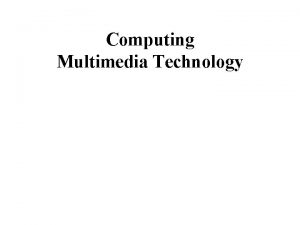Multimedia networking outline 7 1 multimedia networking applications

































- Slides: 33

Multimedia networking: outline 7. 1 multimedia networking applications 7. 2 streaming stored video 7. 3 voice-over-IP Multmedia Networking 7 -1

Text v v v A character: 1 byte Reading speed: 1000 characters per minute Bit rate for text: 1 Kbyte/min = 160 bps Multmedia Networking 7 -2

Multimedia: audio v analog audio signal sampled at constant rate § telephone: 8, 000 samples/sec § CD music: 44, 100 samples/sec each sample quantized, i. e. , rounded § e. g. , 28=256 possible quantized values § each quantized value represented by bits, e. g. , 8 bits for 256 values quantization error audio signal amplitude v quantized value of analog value analog signal time sampling rate (N sample/sec) Multmedia Networking 7 -3

Multimedia: audio v example: 8, 000 samples/sec, 256 quantized values: 64, 000 bps receiver converts bits back to analog signal: § some quality reduction example rates v v v CD: 1. 411 Mbps =44100 samples/sx 16 bits X 2(stero) MP 3: 96, 128, 160 kbps Internet telephony: 5. 3 kbps and up quantization error audio signal amplitude v quantized value of analog value analog signal time sampling rate (N sample/sec) Multmedia Networking 7 -4

Multimedia: images v v v digital image: array of pixels § each pixel represented by bits § 3072 X 2048 pixels. X 36 bits/pixel An image = 3072 X 2048 X 36 bits = 226 Mbits 1, 000 words = 6, 000 characters = 6, 000 bytes=48 Kbits Conventional Wisdom: A picture is worth 1000 words In digital domain: A picture is much more than 1000 words Compression ratio: § 20 -200 § spatial coding example: instead of sending N values of same color (all purple), send only two values: color value (purple) and number of repeated values (N) Multmedia Networking 7 -5

Multimedia: video v v video: sequence of images displayed at constant rate § e. g. 24 images/sec coding: use redundancy within and between images to decrease # bits used to encode image § spatial (within image) § temporal (from one image to next) spatial coding example: instead of sending N values of same color (all purple), send only two values: color value (purple) and number of repeated values (N) ……………………. . . … frame i temporal coding example: instead of sending complete frame at i+1, send only differences from frame i+1 Multmedia Networking 7 -6

Multimedia: video v v v CBR: (constant bit rate): video encoding rate fixed VBR: (variable bit rate): video encoding rate changes as amount of spatial, temporal coding changes examples: § MPEG 1 (CD-ROM) 1. 5 Mbps § MPEG 2 (DVD) 3 -6 Mbps § MPEG 4 (often used in Internet, < 1 Mbps) spatial coding example: instead of sending N values of same color (all purple), send only two values: color value (purple) and number of repeated values (N) ……………………. . . … frame i temporal coding example: instead of sending complete frame at i+1, send only differences from frame i+1 Multmedia Networking 7 -7

Multimedia networking: 3 application types v streaming, stored audio, video § streaming: can begin playout before downloading entire file § stored (at server): can transmit faster than audio/video will be rendered (implies storing/buffering at client) § e. g. , You. Tube, Netflix, Hulu v conversational voice/video over IP § interactive nature of human-to-human conversation limits delay tolerance § e. g. , Skype v streaming live audio, video § e. g. , live sporting event (futbol) Multmedia Networking 7 -8

Multimedia networking: outline 7. 1 multimedia networking applications 7. 2 streaming stored video 7. 3 voice-over-IP Multmedia Networking 7 -9

Cumulative data Streaming stored video: 1. video recorded (e. g. , 30 frames/sec) 2. video sent network delay (fixed in this example) 3. video received, played out at client (30 frames/sec) time streaming: at this time, client playing out early part of video, while server still sending later part of video Multmedia Networking 7 -10

Streaming stored video: challenges continuous playout constraint: once client playout begins, playback must match original timing § … but network delays are variable (jitter), so will need client-side buffer to match playout requirements v other challenges: § client interactivity: pause, fast-forward, rewind, jump through video § video packets may be lost, retransmitted v Multmedia Networking 7 -11

Streaming stored video: revisted client video reception variable network delay constant bit rate video playout at client buffered video Cumulative data constant bit rate video transmission time client playout delay v client-side buffering and playout delay: compensate for network-added delay, delay jitter Multmedia Networking 7 -12

Client-side buffering, playout buffer fill level, Q(t) playout rate, e. g. , CBR r variable fill rate, x(t) video server client application buffer, size B client Multmedia Networking 7 -13

Client-side buffering, playout buffer fill level, Q(t) variable fill rate, x(t) video server � playout rate, e. g. , CBR r client application buffer, size B client 1. Initial fill of buffer until playout begins at tp 2. playout begins at tp, 3. buffer fill level varies over time as fill rate x(t) varies and playout rate r is constant Multmedia Networking 7 -14

Client-side buffering, playout buffer fill level, Q(t) playout rate, e. g. , CBR r variable fill rate, x(t) video server client application buffer, size B playout buffering: average fill rate (x), playout rate (r): v v x < r: buffer eventually empties (causing freezing of video playout until buffer again fills) x > r: buffer will not empty, provided initial playout delay is large enough to absorb variability in x(t) § initial playout delay tradeoff: buffer starvation less likely with larger delay, but larger delay until user Multmedia Networking 7 -15 begins watching

Streaming multimedia: UDP v v v server sends at rate appropriate for client § often: send rate = encoding rate = constant rate § transmission rate can be oblivious to congestion levels short playout delay (2 -5 seconds) to remove network jitter error recovery: application-level, timepermitting RTP [RFC 2326]: multimedia payload types UDP may not go through firewalls Multmedia Networking 7 -16

Streaming multimedia: HTTP v v multimedia file retrieved via HTTP GET send at maximum possible rate under TCP � video file TCP send buffer server v variable rate, x(t) � � TCP receive buffer application playout buffer client fill rate fluctuates due to TCP congestion control, retransmissions (in-order delivery) larger playout delay: smooth TCP delivery rate HTTP/TCP passes more easily through Multmedia Networking 7 -17 firewalls

Streaming multimedia: DASH v v DASH: Dynamic, Adaptive Streaming over HTTP server: § divides video file into multiple chunks § each chunk stored, encoded at different rates § manifest file: provides URLs for different chunks v client: § periodically measures server-to-client bandwidth § consulting manifest, requests one chunk at a time • chooses maximum coding rate sustainable given current bandwidth • can choose different coding rates at different points in time (depending on available Multmedia Networking 7 -18

Streaming multimedia: DASH v v DASH: Dynamic, Adaptive Streaming over HTTP “intelligence” at client: client determines § when to request chunk (so that buffer starvation, or overflow does not occur) § what encoding rate to request (higher quality when more bandwidth available) § where to request chunk (can request from URL server that is “close” to client or has high available bandwidth) Multmedia Networking 7 -19

Content distribution networks v challenge: how to stream content (selected from millions of videos) to hundreds of thousands of simultaneous users? v option 1: single, large “mega-server” § § single point of failure point of network congestion long path to distant clients multiple copies of video sent over outgoing link …. quite simply: this solution doesn’t scale Multmedia Networking 7 -20

Multimedia networking: outline 7. 1 multimedia networking applications 7. 2 streaming stored video 7. 3 voice-over-IP Multmedia Networking 7 -21

Voice-over-IP (Vo. IP) v Vo. IP end-delay requirement: needed to maintain “conversational” aspect § § v v v higher delays noticeable, impair interactivity < 150 msec: good > 400 msec bad includes application-level (packetization, playout), network delays session initialization: how does callee advertise IP address, port number, encoding algorithms? value-added services: call forwarding, screening, recording emergency services: 911 Multmedia Networking 7 -22

Vo. IP characteristics v speaker’s audio: alternating talk spurts, silent periods. § 64 kbps during talk spurt § pkts generated only during talk spurts § 20 msec chunks at 8 Kbytes/sec: 160 bytes of data v application-layer header added to each chunk v chunk+header encapsulated into UDP or TCP segment application sends segment into socket every 20 msec during talkspurt v Multmedia Networking 7 -23

Vo. IP: packet loss, delay v v network loss: IP datagram lost due to network congestion (router buffer overflow) delay loss: IP datagram arrives too late for playout at receiver § delays: processing, queueing in network; endsystem (sender, receiver) delays § typical maximum tolerable delay: 400 ms v loss tolerance: depending on voice encoding, loss concealment, packet loss rates between 1% and 10% can be tolerated Multmedia Networking 7 -24

Delay jitter variable network delay (jitter) client reception constant bit rate playout at client buffered data Cumulative data constant bit rate transmission time client playout delay v end-to-end delays of two consecutive packets: difference can be more or less than 20 msec (transmission time difference) Multmedia Networking 7 -25

Vo. IP: fixed playout delay v v receiver attempts to playout each chunk exactly q msecs after chunk was generated. § chunk has time stamp t: play out chunk at t+q § chunk arrives after t+q: data arrives too late for playout: data “lost” tradeoff in choosing q: § large q: less packet loss § small q: better interactive experience Multmedia Networking 7 -26

Vo. IP: fixed playout delay § § sender generates packets every 20 msec during talk spurt first packet received at time r first playout schedule: begins at p second playout schedule: begins at p’ Multmedia Networking 5 -27

Adaptive playout delay (1) v v v goal: low playout delay, low late loss rate approach: adaptive playout delay adjustment: § estimate network delay, adjust playout delay at beginning of each talk spurt § silent periods compressed and elongated § chunks still played out every 20 msec during talk spurt adaptively estimate packet delay: (EWMA exponentially weighted moving average, recall TCP RTT estimate): di = (1 -a)di-1 + a (ri – ti) delay estimate after ith packet small constant, e. g. 0. 1 time received - time sent (timestamp) measured delay of ith packet Multmedia Networking 7 -28

Adaptive playout delay (2) v also useful to estimate average deviation of delay, v vi = (1 -b)vi-1 + b |ri – ti – di| v estimates di, vi calculated for every received packet, but used only at start of talk spurt v for first packet in talk spurt, playout time is: playout-timei = ti + di + Kvi remaining packets in talkspurt are played out periodically Multmedia Networking 5 -29

Adaptive playout delay (3) Q: How does receiver determine whether packet is first in a talkspurt? v if no loss, receiver looks at successive timestamps § difference of successive stamps > 20 msec -->talk spurt begins. v with loss possible, receiver must look at both time stamps and sequence numbers § difference of successive stamps > 20 msec and sequence numbers without gaps --> talk spurt begins. Multmedia Networking 7 -30

Voi. P: recovery from packet loss (1) Challenge: recover from packet loss given small tolerable delay between original transmission and playout v v each ACK/NAK takes ~ one RTT alternative: Forward Error Correction (FEC) § send enough bits to allow recovery without retransmission (recall two-dimensional parity in Ch. 5) simple FEC v v v for every group of n chunks, create redundant chunk by exclusive OR-ing n original chunks send n+1 chunks, increasing bandwidth by factor 1/n can reconstruct original n chunks if at most one lost chunk from n+1 chunks, with playout delay Multmedia Networking 7 -31

Voi. P: recovery from packet loss (2) another FEC scheme: v “piggyback lower quality stream” v send lower resolution audio stream as redundant information v e. g. , nominal stream PCM at 64 kbps and redundant stream GSM at 13 kbps v non-consecutive loss: receiver can conceal loss v generalization: can also append (n-1)st and (n-2)nd low-bit rat chunk Multmedia Networking 7 -32

Voi. P: recovery from packet loss (3) interleaving to conceal loss: v v audio chunks divided into smaller units, e. g. four 5 msec units per 20 msec audio chunk packet contains small v v if packet lost, still have most of every original chunk no redundancy overhead, but increases playout delay Multmedia Networking 7 -33
 Software defined networking vs traditional
Software defined networking vs traditional Sandwich paragraph example
Sandwich paragraph example Multimedia and graphics
Multimedia and graphics Graphics application software
Graphics application software Csc253 interactive multimedia
Csc253 interactive multimedia Esa multimedia.esa.int./multimedia/virtual-tour-iss
Esa multimedia.esa.int./multimedia/virtual-tour-iss Multimedia becomes interactive multimedia when
Multimedia becomes interactive multimedia when Hyperactive multimedia
Hyperactive multimedia Dr jacqueline belter
Dr jacqueline belter Optical networking technology
Optical networking technology Networking standards organizations
Networking standards organizations Des in networking
Des in networking Jellyfish networking data centers randomly
Jellyfish networking data centers randomly Cyberops vm
Cyberops vm Information centric networking
Information centric networking Types of social networking sites
Types of social networking sites Six networking objectives
Six networking objectives Mininet sdn tutorial
Mininet sdn tutorial Backbone network components
Backbone network components Pengertian kolaborasi jaringan
Pengertian kolaborasi jaringan Data plane control plane and management plane
Data plane control plane and management plane Identity based networking services
Identity based networking services Applied networking
Applied networking C networking library
C networking library Srv in networking
Srv in networking Stealth network design
Stealth network design Poznan supercomputing and networking center
Poznan supercomputing and networking center Cbne certification
Cbne certification Evolution of computer networking
Evolution of computer networking Networking in a sentence
Networking in a sentence Decision tree
Decision tree What is persuasion and networking
What is persuasion and networking Deterministic lockstep
Deterministic lockstep Hot topics in networking
Hot topics in networking



